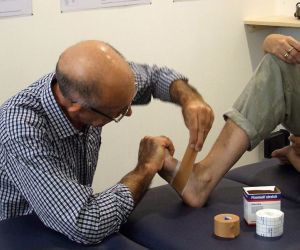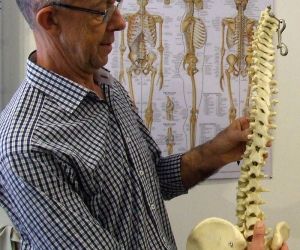What we treat
Lower back pain
Back pain usually arises due to an injury or chronic strain of a disc, ligament or tendon/muscle. If you are stiff in the lower back, muscle release and joint mobilization often improves movement and relieves pain. You will also benefit from home exercises so as you can continue the benefits of treatment at home.
Acute lower back pain, including pain arising from disc injury, often responds well to correct positioning and home exercises.
Chronic lower back pain is often associated with loss of strength and coordination of abdominal, lower back and muscles of the pelvis. Core strengthening exercises, including strengthening for any secondary weakness that has developed in the pelvic region are taught to stabilize and protect spinal structures.
Learning correct sitting postures and lifting/work methods that protect the lower back from further injury are critical to successful long term recovery from injury, pain and disability. Peter will teach you how to position your pelvis so as to achieve a neutral lumbar spinal curve. This lumbar posture will help unload your spine and allow it to heal and recover. Leaning these skills will help you to avoid future injury and degeneration of the spine.
Pelvic Asymmetry
Quite often one side of the pelvis is higher than the other, which also produces apparent uneven leg length. This asymmetry is usually due to weakness in some muscles of the pelvis and overactivity in others. The overactive muscles can cause pain. The asymmetry can cause back pain. Having a level pelvis is important if the spine is to be comfortable. Pelvic symmetry can also be important in reducing hip and knee pain.
Neck pain and Headache
Neck stiffness and pain can be improved with muscle and joint release, postural strategies and home exercises. Headache can arise from a number of causes. One common cause is muscular tension coming from neck muscles and/or spinal joint dysfunction in the upper neck. Muscle release and spinal joint mobilization assist you to achieve better spinal mechanics and reduce headache. Correct sitting and computer workstation set-up is also important when treating neck pain and headache.
Neurological pain in arms and legs
Pain can radiate from pressure on a nerve. Releasing associated joints and muscles, and mobilization of the nerves themselves helps clear radiating pain. People often also suffer from neural tension. This is where the nerve is not sliding freely as you move spine, arms and legs. Neural mobilization methods can be easily learnt and practiced at home. At times neural mobilization is an important factor in recovery from a musculoskeletal injury.
Shoulder, elbow, wrist, hand, and fingers
Pain and stiffness are best treated with careful assessment of joint movement, strength and flexibility. Peter treats with manual therapy and home exercises. Attention is given to possible neural involvement.
Hips, knees, ankles and feet
Hips are treated with release of tight muscles and strengthening where there is muscle imbalance. Pain can be of arthritic origin. While arthritis cannot be reversed, maintaining good strength and flexibility can improve your ability to walk and move normally.
Knees pain is a common reason for seeing a physiotherapist. Peter will assess your knees for ligament and meniscus damage and ensure your patella (knee cap) is tracking correctly. Sometimes knee pain is related to pelvic asymmetry and/or muscle weakness, which can often be corrected. Home exercise is often the best approach to treatment.
Ankle injuries may require taping to unload injured ligaments. Peter will check for joint stiffness and mobilize affected joints in your ankle and foot. Strengthening exercises are usually indicated to protect the ankle from further injury and to allow return to normal activity. Balance and proprioception exercises are also an important part of the rehabilitation process.
Proprioception is the brain's awareness of where body parts are in space. Proprioception is often decreased after an ankle injury. Good proprioception allows the brain to know your ankle is going over before it happens, and recruit muscles to stop the injury. This normally happens without you being aware of it. Peter will teach you proprioception exercises to restore this important sense.
Foot pain can be due to joint and ligament problems. Pronation (flat feet) is often a problem. Plantar fasciitis is another common problem. If orthotics are required Peter will refer you to the best option for you.
Work injuries
Peter has a strong background in managing workplace injuries within the workers compensation system. Treatment is based around identifying the injury and its cause, building confidence for recovery, manual therapy and exercises to loosen tight structures and exercises to strengthen weak muscles. Peter teaches safe work postures/methods to aid recovery and prevention of re-injury.
Workplace visits can be arranged to assist with suitable duties planning, and/or provide manual handling training, office set up and ergonomic assessment to help avoid recurrence.
Core stability
Core strength relates to the muscles of the abdomen and pelvic floor. Core strength is essential to maintaining stability in the lumbar spine. Core strength is often lost after injury or periods of lower back pain. In cases where manual therapy to joints and muscles does not give lasting relief, the problem can be intervertebral instability. In this situation spinal joints become too loose, move too far and stress ligaments and small muscles around the spine. Pain is the result. Improved core stability can be achieved by learning specific abdominal exercises that you can do at home as floor exercises and/or fit ball exercises with graded resistance and difficulty.
Stability and anatomical positioning is also important for the shoulder girdle. If the shoulder blades are positioned poorly on the rib cage, the biomechanics of the shoulder joints is adversely affected. Building stability and good positioning of the shoulder blades can be an effective treatment strategy for chronic shoulder problems.
Overuse injuries
The best approach is an assessment of repetitive tasks/postures and consideration of possible workplace modification. Treatment requires release of tight joints and muscles, strengthening exercises and pause exercises. You may need to strengthen other body parts to help take the load off the painful body part and/or alter your work method.
Sports injuries
Peter sees a full range of sports injuries. There can be underlying muscle weakness or imbalance. He will look closely at sports methods and movements. Peter aims to find the cause of the injury then use a combination of strapping, stretching, strengthening and sports technique modification to address the issue that has arisen.
Problems associated with yoga
Technique, modifications - often too much flexibility and not enough strength. Let Peter see what is causing the problem and find ways to improve or modify technique. Specific strengthening or stretching may be required.
Problems associated with cycling
Discuss issues, bike adjustment, riding posture, stretch tight muscles and strengthen weak muscle groups to balance forces.
Peter is a regular road cyclist.
Management of acute injuries
It is usually best to rest, apply ice and elevate and compress the body part if possible after injury. Peter will assess a new injury to determine which tissues are injured and plan for the best treatment approach.
If you have injured your lower back Peter will show you helpful positioning techniques and introduce gentle exercises. It is important to recognise that most acute injuries resolve by themselves as the body's healing process takes place. Identifying what has happened, and the need for possible medical review and/or scanning, will help give peace of mind and allow you to recover without unnecessary anxiety.
Physical Rehabilitation
Rehabilitation after fractures, surgery, strains and strains. Peter will carefully assess your needs, use manual therapy to relax tight structures and use manually guided exercises to help you on the road to recovery. As you improve Peter will show you home exercises to further improve movement flexibility and strength.
Vehicle seating - adjustment and adding support
People often suffer unnecessary pain and discomfort due to incorrect adjustment of the seat and steering wheel. Often extra support is required - especially when discomfort is experienced.
Peter will assess the needs of individual drivers or provide ergonomic advice when purchase decisions are being made.


